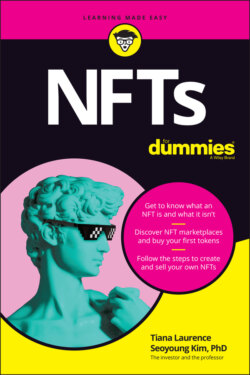Читать книгу NFTs For Dummies - Tiana Laurence - Страница 13
Finding Out How an NFT Works
ОглавлениеPeople often confuse the NFT itself with what the NFT was built to represent. An NFT is a cryptographically secure digital record that verifies your ownership of or access to, say, a piece of digital art — sort of like how your car title verifies ownership of your vehicle. You don’t really own the car in your possession without the title, and you don’t really own the CryptoKitty in your collection of jpegs without the corresponding NFT.
For example, consider the cryptocollectible known as Mutant Ape Yacht Club (MAYC). This strange new collection of mutant apes (who may or may not be part of a yacht club?) is the latest rage among NFT collectors and is now the most active ERC-721 token out there. (See Figure 1-5.) But what exactly does it mean to own a particular MAYC?
FIGURE 1-5: MAYCs listed for public sale on OpenSea.
When browsing MAYCs for sale on OpenSea (one of the NFT marketplaces you can discover in Chapter 4 and Chapter 12), you notice provocative graphics and characteristics presented on the marketplace platform. (Refer to Figure 1-5.) What you’re seeing are the visual representations of each individual MAYC — but the NFT itself is the unique digital code that’s secured on the Ethereum blockchain.
For instance, consider MAYC #7632 in the upper left corner of Figure 1-5. Purchasing this NFT means that you’re now the rightful owner of record of TokenID 7632, which is in storage in the contract account 0x60e4d786628fea6478f785a6d7e704777c86a7c6 on the Ethereum blockchain. All transfers of ownership will be memorialized on the blockchain so that provenance of MAYC #7632 and its current rightful owner can always be known, as shown in Figure 1-6.
FIGURE 1-6: MAYC #7632.
As of this writing, 14,688 MAYCs exist across 7,709 holders. You can check out the individual details and ownership of each unique MAYC at https://etherscan.io/token/0x60e4d786628fea6478f785a6d7e704777c86a7c6.
The digital art you purchase is easy to duplicate. (Pressing the PrintScreen key on the keyboard requires little to no training.) However, because the NFT is secured on a public blockchain, it’s far more difficult to illegally transfer, duplicate, or otherwise hack. The beauty of NFTs lies in the underlying technology — a nexus of smart contracts and distributed network of validators — that allows you to reliably and automatically verify who truly owns each of the 14,688 mutant ape NFTs.
Thus, our mutant apes are part of a greater decentralized ecosystem where records are kept in a public and trustless manner, which means that we don’t need a trusted central party, such as Bank of America, to maintain a reliable and secure system to track our mutant apes for us. In their peculiar way, these mutant apes are bringing further awareness to the burgeoning landscape of decentralized finance (DeFi) and decentralized autonomous organizations (DAOs). (To read more about DAOs, check out Chapters 4 and 6.)
The majority of NFTs are minted as ERC-721 tokens on Ethereum. Thus, as shown in Figure 1-6, the provenance of each token is memorialized on the public Ethereum blockchain. Each subsequent transaction is validated and executed by a distributed network of miners — much like the system securing the Bitcoin blockchain.
Because an NFT is secured on a robust and tested blockchain (to date, the Ethereum blockchain has never been hacked), developers of nascent projects can piggyback off the existing system in place to secure ownership records and reward systems within the latest sub-economy under development. We caution though, that, although the Ethereum blockchain itself has yet to be hacked, individual smart contracts deployed on Ethereum have. Thus, the recommended practice is to use vetted libraries that provide prebuilt smart contracts implementing development standards that have been reviewed and finalized by the greater community of core developers.
We promise that the preceding paragraph makes much more sense after you dive into the technical chapters in Part 3 of this book.
